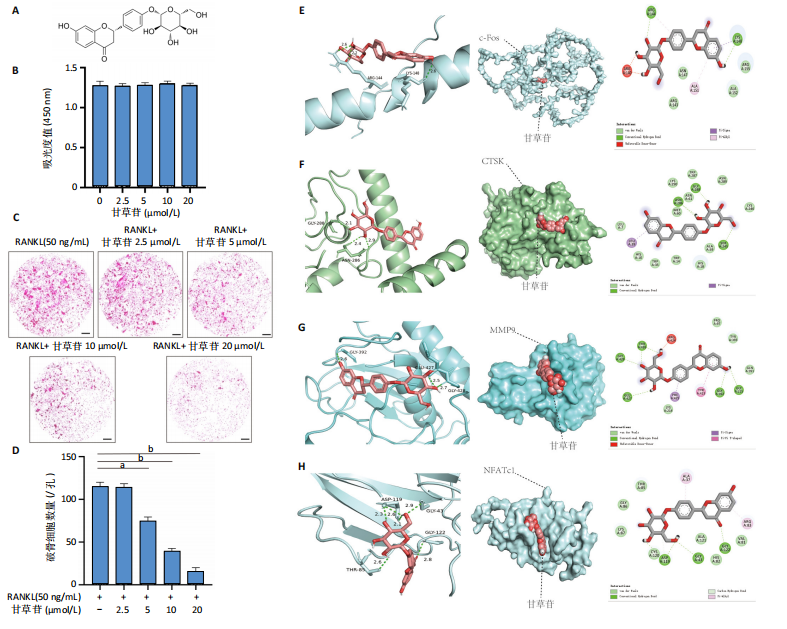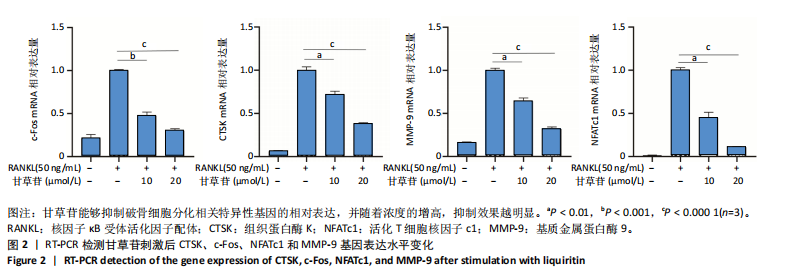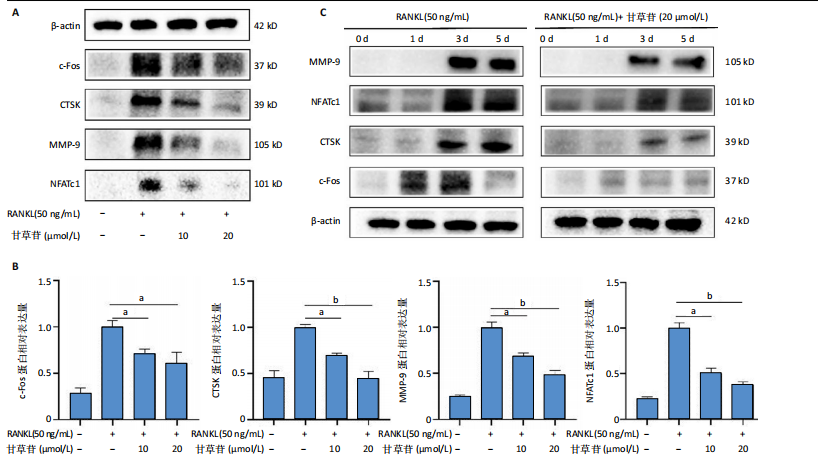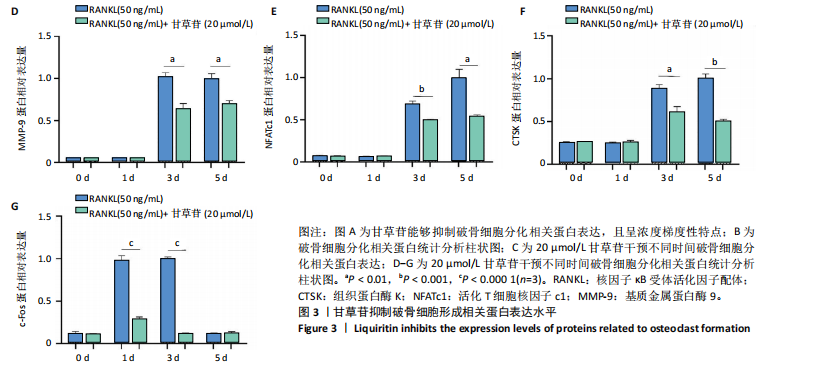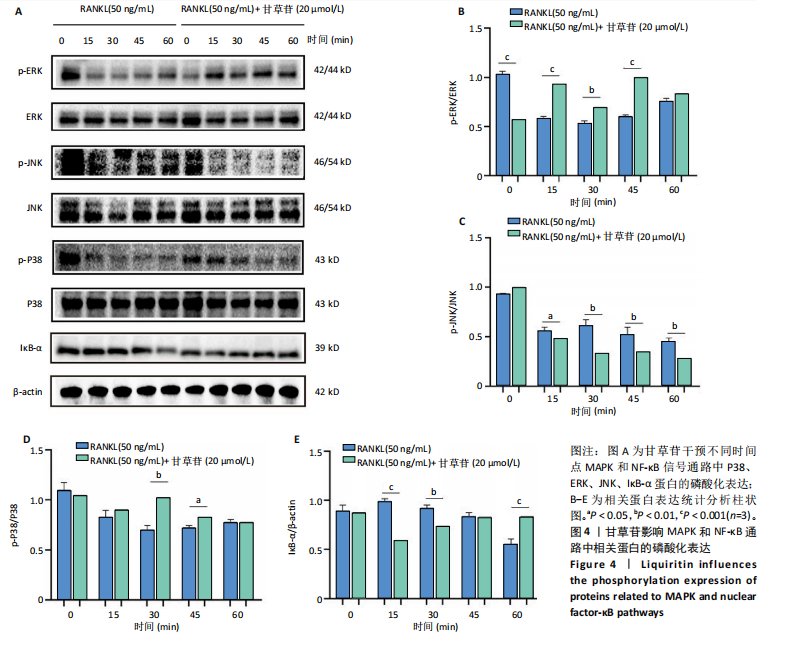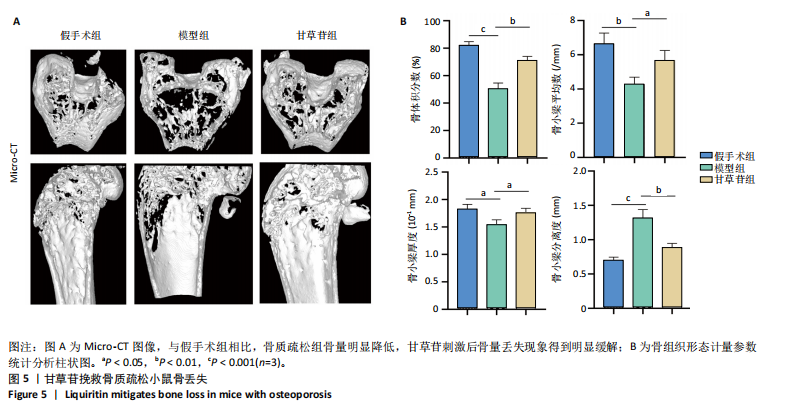[1] BROWN JP. Long-Term Treatment of Postmenopausal Osteoporosis. Endocrinol Metab (Seoul). 2021;36(3):544-552.
[2] LANGDAHL BL. Overview of treatment approaches to osteoporosis. Br J Pharmacol. 2021;178(9):1891-1906.
[3] CHAN WCW, TAN Z, TO MKT, et al. Regulation and Role of Transcription Factors in Osteogenesis. Int J Mol Sci. 2021;22(11):5445.
[4] HONG G, CHEN Z, HAN X, et al. A novel RANKL-targeted flavonoid glycoside prevents osteoporosis through inhibiting NFATc1 and reactive oxygen species. Clin Transl Med. 2021;11(5):e392.
[5] CLYNES MA, HARVEY NC, CURTIS EM, et al. The epidemiology of osteoporosis. Br Med Bull. 2020;133(1):105-117.
[6] QIN J, CHEN J, PENG F, et al. Pharmacological activities and pharmacokinetics of liquiritin: A review. J Ethnopharmacol. 2022;293: 115257.
[7] YANG X, DANG X, ZHANG X, et al. Liquiritin reduces lipopolysaccharide-aroused HaCaT cell inflammation damage via regulation of microRNA-31/MyD88. Int Immunopharmacol. 2021;101(Pt B):108283.
[8] 张建新,杨孝来.甘草苷抑制吗啡引起的神经损伤作用及机制[J]中国临床药理学与治疗学,2024,29(5):554-560.
[9] QIU M, CHENG L, XU J, et al. Liquiritin reduces chondrocyte apoptosis through P53/PUMA signaling pathway to alleviate osteoarthritis. Life Sci. 2024;343:122536.
[10] GUO D, WANG Q, LI A, et al. Liquiritin targeting Th17 cells differentiation and abnormal proliferation of keratinocytes alleviates psoriasis via NF-κB and AP-1 pathway. Phytother Res. 2024;38(1): 174-186.
[11] ZHOU H, YANG T, LU Z, et al. Liquiritin exhibits anti-acute lung injury activities through suppressing the JNK/Nur77/c-Jun pathway. Chin Med. 2023;18(1):35.
[12] WANG R, CHEN Y, WANG Z, et al. Antidepressant effect of licorice total flavonoids and liquiritin: A review. Heliyon. 2023;9(11):e22251.
[13] XIA X, ZHANG Y, ZHU L, et al. Liquiritin apioside alleviates colonic inflammation and accompanying depression-like symptoms in colitis by gut metabolites and the balance of Th17/Treg. Phytomedicine. 2023;120:155039.
[14] IANTOMASI T, ROMAGNOLI C, PALMINI G, et al. Oxidative Stress and Inflammation in Osteoporosis: Molecular Mechanisms Involved and the Relationship with microRNAs. Int J Mol Sci. 2023;24(4):3772.
[15] WU D, CLINE-SMITH A, SHASHKOVA E, et al. T-Cell Mediated Inflammation in Postmenopausal Osteoporosis. Front Immunol. 2021; 12:687551.
[16] ROTTA D, FASSIO A, ROSSINI M, et al. Osteoporosis in Inflammatory Arthritides: New Perspective on Pathogenesis and Treatment. Front Med (Lausanne). 2020;7:613720.
[17] DENG W, HUANG Y, LI H, et al. Dehydromiltirone inhibits osteoclast differentiation in RAW264.7 and bone marrow macrophages by modulating MAPK and NF-κB activity. Front Pharmacol. 2022;13: 1015693.
[18] CHEN K, LIAO S, LI Y, et al. Osteoblast-derived EGFL6 couples angiogenesis to osteogenesis during bone repair. Theranostics. 2021; 11(20):9738-9751.
[19] YAN C, ZHANG J, AN F, et al. Research Progress of Ferroptosis Regulatory Network and Bone Remodeling in Osteoporosis. Front Public Health. 2022;10:910675.
[20] FISCHER V, HAFFNER-LUNTZER M. Interaction between bone and immune cells: Implications for postmenopausal osteoporosis. Semin Cell Dev Biol. 2022;123:14-21.
[21] 吴凤爱,逯青霞,侯贵明,等.甘草苷对血管紧张素Ⅱ诱导的心肌细胞肥大的影响[J].中国临床药理学杂志,2023,39(19):2780-2784.
[22] 曲欣妮,李文标,王利,等.基于网络药理学及实验验证探讨甘草苷治疗帕金森病的作用机制[J].世界科学技术-中医药现代化, 2023,25(5):1689-1701.
[23] LIU C, YUAN D, ZHANG C, et al. Liquiritin Alleviates Depression-Like Behavior in CUMS Mice by Inhibiting Oxidative Stress and NLRP3 Inflammasome in Hippocampus. Evid Based Complement Alternat Med. 2022;2022:7558825.
[24] THU VT, YEN NTH, LY NTH. Liquiritin from Radix Glycyrrhizae Protects Cardiac Mitochondria from Hypoxia/Reoxygenation Damage. J Anal Methods Chem. 2021;2021:1857464.
[25] IBÁÑEZ L, NÁCHER-JUAN J, TERENCIO MC, et al. Osteostatin Inhibits M-CSF+RANKL-Induced Human Osteoclast Differentiation by Modulating NFATc1. Int J Mol Sci. 2022;23(15):8551.
[26] UDAGAWA N, KOIDE M, NAKAMURA M, et al. Osteoclast differentiation by RANKL and OPG signaling pathways. J Bone Miner Metab. 2021; 39(1):19-26.
[27] YANG Y, LIU Z, WU J, et al. Nrf2 Mitigates RANKL and M-CSF Induced Osteoclast Differentiation via ROS-Dependent Mechanisms. Antioxidants (Basel). 2023;12(12):2094.
[28] FAN J, XU C, SHI H, et al. Hesperetin affects osteoclast differentiation via MAPK signaling pathway. Adv Clin Exp Med. 2023 Dec 12. doi: 10.17219/acem/174393.
[29] KOGA Y, TSURUMAKI H, AOKI-SAITO H, et al. Roles of Cyclic AMP Response Element Binding Activation in the ERK1/2 and p38 MAPK Signalling Pathway in Central Nervous System, Cardiovascular System, Osteoclast Differentiation and Mucin and Cytokine Production. Int J Mol Sci. 2019;20(6):1346.
[30] LI Y, ZHUANG Q, TAO L, et al. Urolithin B suppressed osteoclast activation and reduced bone loss of osteoporosis via inhibiting ERK/NF-κB pathway. Cell Prolif. 2022;55(10):e13291.
[31] CHOI EB, AGIDIGBI TS, KANG IS, et al. ERK Inhibition Increases RANKL-Induced Osteoclast Differentiation in RAW 264.7 Cells by Stimulating AMPK Activation and RANK Expression and Inhibiting Anti-Osteoclastogenic Factor Expression. Int J Mol Sci. 2022;23(21):13512.
[32] FUJII S, ISHIBASHI T, KOKURA M, et al. RAF1-MEK/ERK pathway-dependent ARL4C expression promotes ameloblastoma cell proliferation and osteoclast formation. J Pathol. 2022;256(1):119-133.
[33] DONG Y, SONG K, WANG P, et al. Blocking the cytohesin-2/ARF1 axis by SecinH3 ameliorates osteoclast-induced bone loss via attenuating JNK-mediated IRE1 endoribonuclease activity. Pharmacol Res. 2022; 185:106513.
[34] MA Z, YU R, ZHAO J, et al. Constant hypoxia inhibits osteoclast differentiation and bone resorption by regulating phosphorylation of JNK and IκBα. Inflamm Res. 2019;68(2):157-166.
[35] YANG J, ZHANG L, DING Q, et al. Flavonoid-Loaded Biomaterials in Bone Defect Repair. Molecules. 2023;28(19):6888.
[36] CHENG LY, JIN XL, CHEN XW, et al. Icariin inhibits thioacetamide-induced osteoclast differentiation through RANKL-p38/ERK-NFAT pathway. Zhongguo Zhong Yao Za Zhi. 2022;47(21):5882-5889.
[37] SHEN Y, WANG Z, TAN J, et al. TRAF6/ERK/p38 pathway is involved in interleukin-17-mediated autophagy to promote osteoclast precursor cell differentiation. Zhejiang Da Xue Xue Bao Yi Xue Ban. 2021;50(2): 162-170.
[38] GAO Y, CHEN N, FU Z, et al. Progress of Wnt Signaling Pathway in Osteoporosis. Biomolecules. 2023;13(3):483.
[39] XUE C, LUO H, WANG L, et al. Aconine attenuates osteoclast-mediated bone resorption and ferroptosis to improve osteoporosis via inhibiting NF-κB signaling. Front Endocrinol (Lausanne). 2023;14:1234563.
[40] JI H, PAN Q, CAO R, et al. Garcinone C attenuates RANKL-induced osteoclast differentiation and oxidative stress by activating Nrf2/HO-1 and inhibiting the NF-kB signaling pathway. Heliyon. 2024;10(3): e25601.
[41] CHANG J, WANG Z, TANG E, et al. Inhibition of osteoblastic bone formation by nuclear factor-kappaB. Nat Med. 2009;15(6):682-689.
[42] YASUDA H. Discovery of the RANKL/RANK/OPG system. J Bone Miner Metab. 2021;39(1):2-11.
[43] HONG G, ZHOU L, ZHENG G, et al. A novel Glycyrrhiza glabra extract liquiritin targeting NFATc1 activity and ROS levels to counteract ovariectomy-induced osteoporosis and bone loss in murine model. Front Pharmacol. 2023;14:1287827.
|
